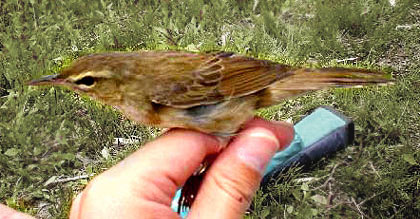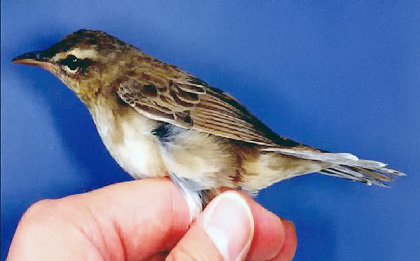breeding on Ulleung Island.
[ABSTRACT]
"Online Document Title:
Observation of New Species Recorded in South Korea.
National Institute of Environmental Research (NIER)
Dr. Kim Chang Hoe (NIER) and Dr. Nishiumi Isao of the National Science Museum.
Abstract
The individual recognized as a new species in Ulleung Island had been identified as a Styan's Grasshopper Warbler Locustella pleskei when first observed, but is shows major differences structurally between Styan's and Middendorff's Grasshopper Warbler Locustella ochotensis. DNA analysis was therefore conducted comparing samples with both Styan's and Middendorf's Grasshopper Warblers.
Individuals analysed were comprised of 4 individuals from Ulleung Island, 2 pleskei from Wando, 3 pleskei from Mikurajima in Japan (Izu Islands), 6 ochotensis from Kamchatka, and 1 ochotensis from Hokkaido.
Characteristics of birds on Ulleung Island:


Structurally (morphologically?) between Styan's and Middendorff's
Differs systematically from Styan's and Middendorff's
Closest genetically to Styan's from Wando
The island has been separated from the mainland for 40 000 to 60 000 years; enough time for a new species to develop (Birds Korea: very approximate translation)
Research will be published following more studies on the specimens, and its distribution etc.
Styan's is classified as a Vulnerable species, breeding on small islands off Korea and Japan. It was considered until a decade ago a subspecies of Middendorff's, though it shows significant differences in structure and in vocalizations.
Morphological Characteristics:
The overall plumage tones are bright brown, similar to Middendorff's, but different from the grayer plumage tones of the Styan's nesting on Wando and Mikurajima.
Wing structure resembles Styan's (3>4>2>5), and is different from Middendorff's (3>2>4>5).
Bill length: 14.5 - 15.3 mm. Shorter than Styan's (15.2 - 15.9 mm) and longer than Middendorff's (11.5 - 14.0 mm).
As a result of analyzing Styan's in Wando and Mikuarjima these birds are included in the same systematic population; the Ulleung individuals are therefore more similar to the Styan's in Wando than to the Middendorff's in Kamchatka."
A new endemic species or not?
The relationship between Styan's Locustella pleskei, Middendorff's L. ochotensis and Pallas's Grasshopper/Rusty-rumped Warbler L. certhiola, remains little understood, with various populations appearing to show intermediate characteristics (including both measurements and plumage), while others appear to show characteristics outside of the range of other populations/species.
As the authors of this report suggest, further work, requiring DNA analysis and comparison of the diagnostic characteristics of the Ulleung birds with populations of other birds elsewhere in the region, needs to be undertaken.
Our aim in reproducing the online abstract and images at this time is therefore simply to inform others of the work being conducted here in South Korea, on Ulleung.
For some further insight into the complexity of the regional taxa involved, go to: surfbirds.com/ID%20Articles/Midd1.html.
NB: In recent correspondence on the "Ulleung Warbler" and Far Eastern Locustellas in general, warbler specialist Peter KENNERLEY has advised:
"My only caveat to this [Surfbirds article] is that it was suggested that the Talan birds could be subcerthiola. We are now more familiar with the variation found in Middendorff's, and can say with certainty, that they do not resemble the type specimens (2) of subcerthiola (from Kamchatka) held in Tring. Most Tring specimens of Middendorff's closely resemble subcerthiola and were collected in coastal China on migration.
The identity of the Talan birds remains unresolved. A Russian paper discusses this further:
Kalyakin, M.V. et al., 1993. "On the problem of systematic relations between Pallas' Grasshopper (Locustella certhiola) and Middendorff' Grasshopper (Locustella ochotensis)". Pages 164-182 In 161-223. In Hibridizaciya i problema vida u pozvonochnikh (O.D. Rossolino, ed.) -- Moscow State University Press, Moscow.
In the summary in English it says:"Studies of colour and measurements of the Pallas' and the Middendorff's Grasshoppers recently collected in the Lower Amur River area and on Sakhalin Island revealed wide hybridisation at these areas and near Magadan (Talan island). It is supposed that the hybridisation results from secondary contact of two forms previously diverged in time of their geographical isolation. Their specific status proposed by other authors is accepted".This paper does not, however, discuss why the 'hybrids' on Talan are larger than both Pallas's and Middendorff's and show characters not found in either species. Furthermore, it was written before the advent of DNA investigation.
So the true picture has yet to be resolved, and Kalykin's paper, while relevant 10 years ago, should now be treated with caution until genetic testing establishes where these birds fit into the larger picture.
Investigation of the Talan birds and any populations inhabiting the adjacent mainland should form a part of this overall review.This entire complex is really interesting and is worthy of further investigation.



